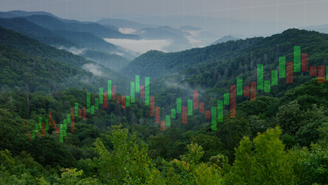August 25, 2023: Please note this article has been updated since its original publication with revised figures and statistics.
As the physical impacts of climate change increase in severity and frequency, awareness of how they affect individuals, companies, and financial institutions is becoming more mainstream. While some data and tools are available for governments and individuals to assess their exposure to physical climate risks,1 institutional investors face unique challenges around making informed decisions on physical climate risk. They must assess physical climate risk at a global scale, and they must consider a wide range of mechanisms through which physical climate risks impact their investments across the value chain. Additionally, investors must manage and assess risks on varied time scales, depending on how their investments are structured.
Despite these complexities, institutional investors need clear insights into how physical climate change may impact their investments, both today and in the future. As with other risk channels, such as market and regulatory risks, investors require granular data to be able to make informed financial decisions and remain competitive. And they need to translate physical climate risks into an assessment of the resulting material financial impact on their portfolio companies.
Impacts of Physical Climate Risks on Companies
The impacts of physical climate risks can create a significant drain on company finances. The costs of damage to physical assets, along with lost revenue, will negatively affect a company’s bottom line. The average (mean) value for each sector shows that many are vulnerable to significant losses from physical climate risks. In particular, the average energy companies in the product universe may experience cumulative direct losses of over US$1.6 billion between now and 2050 in a hot house world scenario (RCP8.5) where global emissions continue to rise throughout the century. Investors should examine their portfolio companies to understand how they may be affected.
Figure 1: Average Cumulative Direct and Indirect Losses in a Hot House World Scenario by 2050 (RCP8.5)
.png?sfvrsn=e9529ff1_1)
Source: Morningstar Sustainalytics. For informational purposes only.
Direct and Indirect Physical Climate Risks Defined
Material financial impacts of physical climate risks can be categorized into direct and indirect risks. Direct physical climate risks include things like impairment costs and productivity loss. For example, a grain processing plant that is damaged by flooding and wind will incur costs from repairing the building and equipment, as well as lost revenue from the associated downtime.
Indirect physical climate impacts can disrupt the supply and demand of the business value chain. In the grain processing plant example, if the plant itself is not damaged by flooding, damage to nearby railroads and highways that it relies on to receive and export its inputs and outputs would negatively impact its operating capacity. Both direct and indirect risks cover important sections of the business value chain for portfolio companies, and reporting frameworks such as the Taskforce for Climate-related Financial Disclosure (TCFD) have recognized the importance of capturing this full spectrum of risks.
Potential Losses Due to Direct Physical Climate Risks
Losses from direct physical climate risks include those resulting from impacts to assets that a company owns or leases. These losses can manifest themselves as either lost property values due to damage sustained to a physical asset, or lost revenue resulting from interruptions in productive capacity.
In a hot house world scenario, the average company in Morningstar Sustainalytics’ Physical Climate Risk Metrics universe is expected to lose an equivalent 4.3% of cumulative operating cash flow due to these direct and indirect risks, between now and 2050. The same dataset reveals significant variation between companies, as well as between sectors, depending on their locations, regional revenue, and asset values.
For example, the average information technology company in the Physical Climate Risk Metrics product universe will only lose about 1.7% of operating cash flow between now and 2050 due to direct and indirect risks (Total Loss Ratio of 0.017), while the average energy company in the product universe can expect to lose approximately 5.2% of operating cashflow on these risks during the same period (Total Loss Ratio of 0.052) (See Figure 2 below).
Figure 2: Average Direct and Indirect Loss Ratios by Sector In a Hot House World Scenario (RCP8.5)
.png?sfvrsn=4d7b9c5_1)
Source: Morningstar Sustainalytics. For informational purposes only.
*Note that Indirect Loss Ratio covers the risks to local critical infrastructure surrounding an asset but does not yet include risks to a company’s full supply chain.
Impacts of Indirect Physical Climate Risks
While direct physical climate risks are difficult to quantify, indirect physical climate risks are even more so. Indirect physical climate risks affect the services and resources a company uses, but does not own or control. These risks primarily impact the productive capacity of a company’s assets and can affect both upstream and downstream operations. Damage to critical infrastructure in the region surrounding an asset, such as an electric substation or water purification plant, for example, could impede a company’s ability to operate effectively.
Other examples of how indirect risks affect companies include impacts to the global supply chain as well as to regions and nations. Increasingly interconnected global supply chains and the common use of just-in-time manufacturing systems leave companies vulnerable to disruptions in production and shipping around the world. Companies operating in regions and countries that experience damage from physical hazards are also exposed to volatility in supply and demand, and disruptions to their workforce.
Similar to scope 3 GHG emissions, investors need ways to assess the risks to a company across the business value chain. By studying a company’s exposure to indirect physical climate risks, investors can understand how external forces can affect a company in the regions in which they operate.
For example, in 2021, floods in British Columbia, Canada, washed out rail lines, causing grain producers, transporters, and processors to experience interruptions in access to supply chains.2 In that same year, the Caldor Fire in California cost an estimated tens of millions of dollars in lost economic activity within a single county due to smoke, evacuation, and supply chain interruptions – even though no buildings were damaged in that county.3 In 2022, heat waves in the United Kingdom caused cooling systems to fail at Google’s data centers, impacting clients throughout Europe.4 Risks like these, among others, will continue to grow in severity and frequency as climate change worsens.
Why Investors Need to Pay Attention Mounting Physical Climate Risks
Countries, stock exchanges and industry groups are adopting regulations that require companies and institutional investors to report and disclose their exposure to physical climate risks in alignment with the TCFD’s framework. As these jurisdictions expand the data that is available on physical climate risks, investors will be able to make more sophisticated decisions to manage their exposure to these risks, similar to how available GHG emissions data allows better decision-making around transition risks.
The expectations around how investors should integrate physical climate data into risk management are also growing in sophistication. This is perhaps most evident in the increasing granularity of risk management and business strategy disclosures in regulations like the European Banking Authority Pillar 3 disclosures and the UK Financial Conduct Authority’s TCFD reporting requirements. A working paper from the European Central Bank5 shows that markets are already beginning to price in physical climate risks, albeit at the sector level rather than the issuer level. By leveraging more comprehensive bottom-up information about companies, investors can leverage physical climate risk data as a competitive advantage in a challenging market.
Watch our Physical Climate Risk Metrics videos to learn more about the insights these metrics can give investors into the financial resiliency of their portfolio companies.
References
1 See https://riskfactor.com/
2 Atkins, E. and McGee, N. 2021. “Canada faces grain backlog with freight halted through B.C. after flooding.” November 21, 2021. The Globe and Mail. https://www.theglobeandmail.com/business/article-canada-faces-grain-backlog-with-freight-halted-through-bc-after/.
3 Gedye, G. 2021. “How much do wildfires really cost California’s economy?” October 11, 2021. CalMatters. https://calmatters.org/economy/2021/10/california-wildfires-economic-impact/.
4 Swinhoe,D. 2022. “Google’s London data center outage during heatwave caused by ‘simultaneous failure of multiple, redundant cooling systems.’” August 2, 2022. DataCenterDynamics.com. https://www.datacenterdynamics.com/en/news/googles-london-data-center-outage-during-heatwave-caused-by-simultaneous-failure-of-multiple-redundant-cooling-systems/.
5 Bua, G., Kapp, D., Ramella, F, and Rognone, L. 2022. “Transition versus physical climate risk pricing in European financial markets: a text-based approach.” July 2022. European Central Bank Working Paper Series. https://www.ecb.europa.eu/pub/pdf/scpwps/ecb.wp2677~9fc49e8300.en.pdf.




